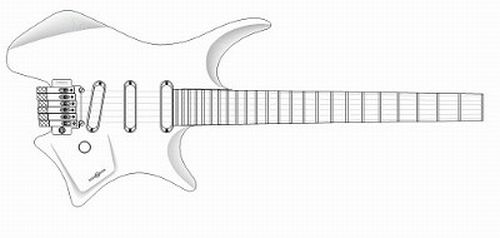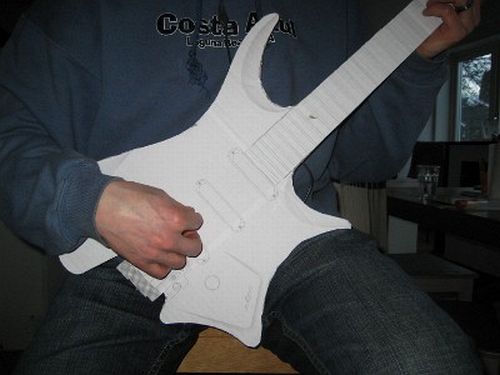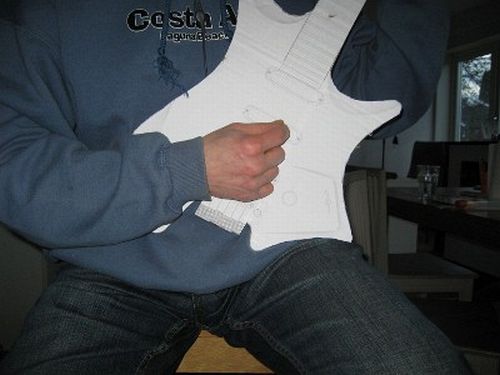Strandberg On the Ergonomic Electric Guitar
Over at Strandberg Guitarworks, Ola Strandberg has been busily documenting his ambitious take on an ergonomic electric guitar.
Ola’s guitar project includes, among other elements, an ergonomic multi-position guitar body, a twisted headless neck and a headless guitar bridge of his own design. For this installment, we’ll focus on the guitar body.

Ola’s guitar design is unlike many of the ergonomic electric guitars we’ve seen before – leaning firmly toward the Strat style rather than the Klein guitar shape. To test out the shape, Ola made the mockup seen here in various playing positions:




Ola Strandberg from .take Your Positions…
Out of the four different playing positions, the last one may not be feasible, but the other three felt very, very good. Next, having verified that it will be a working design, I’ll start making the routing template for the body.
With roughly 10 bass and guitar projects under his belt, Ola has a good deal of experience and if the regularity of updates is any indication, we’ll soon be seeing a successful guitar project come to fruition.
Thanks to Ola Strandberg for permission to reproduce the photos above.
Looks interesting. Is it a headless?
@Ovidiu: Yes it is. Also, this particular drawing doesn’t show it but Ola has a full scale PDF on his site which shows a stub headstock on the headless neck. One of the complaints I’ve heard about headless guitars is that some guitarists feel a bit “lost” without the headstock. So several headless guitar makers have gone the route of including a stub.
That looks fantastic! Great design.
@Steven Clements: Agreed, Steven. Ola is definitely onto to something.
Hi Robert, all!
It’s always fun to see your name in print – thanks a lot for the attention. I look forward to more comments and refinements. I have made my plans available under Creative Commons licensing, so they are downloadable from my site.
Cheers,
Ola
Ola —
Great to see your design migrating site to site…here it is on BTEG. Good use of paper/cardboard to refine the design. Stiff paper is a fast easy medium to work with.
Looking forward to the finished instrument…
But!
Where’s the output jack !?!?
If you have it in alternate positions (as shown) the cable will be in its way. Maybe you’ll run it wireless? :
Now, for headless, and guitarists “losts”. I don’t know what this is, and why HEADLESS should always provide this, but it seems that the 12th fret are showing up earlier, and are always of different distance, comapred to a headstock guitar. It not only seems that all of the neck is moved forward a bit but it is.
However, this has not to do – or should really have nothing to do – with a headstock or not. It’s the bodys position relative to neck. You can take any other guitar and just chop off the headstock. The 12th fret is showing up at the same distance.
I think that Klein, Steinbergers and all, has a neck heel and where the neck joins the body that is too far pushed to the left.
Which means that the bridge and that end of strings always ends where the body ends, because one have to be able to reach the tuners protruding out from the body at the right. The Toone bass had a neck that “carried on” out from the body at the right and had the bridge and tuners there. In such a case, you place the 12th fret at the same distance as it would appear on a regular bass.
However, on instruments where there’s much wood behind the bridge, it OUGHT TO BE even more hard to reach certain places on the neck but it isn’t. Klein, Steinbergers and the likes are made just to have an easy reach to the upper frets, playing solos between 12-24th fret. It seems.
Hi Mats,
good point about the output jack! I haven’t figured it out yet is the truthful answer. Another thing that I haven’t worked out is the fact that it will be difficult to put the guitar down on the floor and make it lean against e.g. a wall. I have been sketching on a variety of fold-out supports that would sit in the knee recess.
To answer the second question, please see this comparison picture which shows my shape superimposed on a strat body. I can easily see why a headless shape would _feel_ different than a regular, but I think the picture shows that there is no clear cut rational explanation. I would also agree with another of your posts that the weight of the headstock and how that affects the movement of a neck will also make a difference.
I will keep you all posted on the output jack 🙂
Sometimes solutions are staring you straight in the face! Good point Robert. I was looking for a clean look of the front of the guitar, perhaps even replacing the 5-position lever switch with a rotary one. But a good looking jack on the front could be made into a feature rather than anything else.
Well, a regular Strat front output jack, leaves it able to lean against a wall, a stand or whatever. I like front end (or top) jacks. Scratches and dents shows up earlier around the jack on A NON VISIBLE jack at the side, than anything that is visible right from the start on the top.
One does not have to “feel its way into the jack” with the plug each time one tries to plug in.
Just my two dents… sorry, cents.
And now for a secret trade tip: Slant (angle) the bridge pickup the other way will you, please? Never understood that one really on regular strats. So that the poles (or rails) of the pickup are in front of the high e-string instead compared to the bottom thick e-string. So that the thick top e-string it’s the closest to the bridge. You will thank me for this… 😉
Examples: The Fender Dick Dale or Hendrix Voodo singature custom shop strats. See web for picures. They’re all over the place.
It’s the high shrill E-string that bugs me on regular ones. And when doing volume swells with you picking hands pinky, you will thank me. The high e-string has a slightly higher amplitude further away from the bridge, and gives a SLIGHTLY (but very noticeable) higher input to the magnet of the pickup. And the overtones, harmonics are not so shrill. You get rid of the “ICEPICK” in your ear treble. The thick e-string will have more twang to it.
It will not get in the way for your picking hands direction, trust me.
@Mats: I feel similarly about the use of front mounted jacks. Of course, you could do what Rick Toone does on his Orchid bass and include a large plate around the output jack thus protecting the guitar itself.
Hmm. I’ll have to consider the reversed bridge pickup next time around. Seems like some interesting advantages…
But it’s only if you have those single coils, that has to be aligned and slanted to have the pole pieces right under the each string. On a P-90 pu, or a humbucker it’s totally irrelevant.
Single coils a la Seymour Duncans with TWIN RAILS in it, will also have less effect or none at all. Joe Bardens too.
I mean, some pickups have just a single rail in them (Bill Lawrences), so these have to be angled in the other way too.
@The Fender Lace pickups I used in project guitar 1 are supposed to have a rather wide sensing area under the strings but I suppose they could benefit as well from this approach.
I have some input on the jack discussion.
Ola, take a look at Brian Moore Guitars and look at the jack. its in the back of the guitar just above the strap. it stays out of the way and looks cool too.
you can kind of see it in this picture….
http://www.chrisguitars.com/brian-i81-turq.jpg
[…] in March last year (!), Mats over at eLutherie.org raised the question of where to place the output jack in the EGS design. Since then, I have been so focused on hardware […]